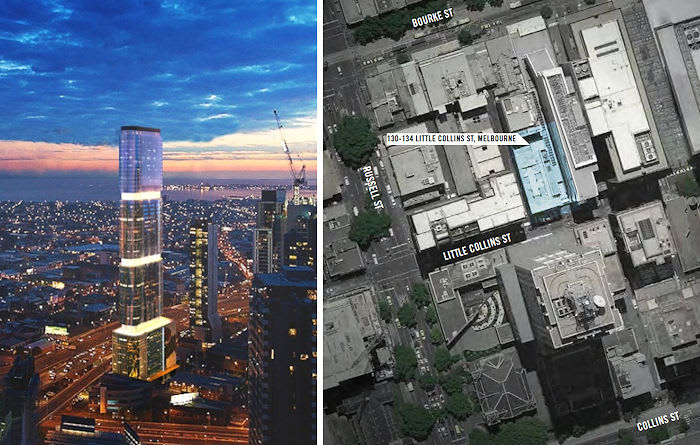C270 on show: the case studies of 42 Moray Street and 130 Little Collins Street
Two evidentiary documents published by the Department of Environment, Land, Water and Planning (DELWP) in recent times have provided insight into the effects of Amendment C270 upon key proposed development sites.
Located in both Southbank and the CBD, either site would be considerably hamstrung in terms of the project size and subsequent design outcomes, should the respective developers choose to proceed with their potential projects.
With Southbank and the Melbourne CBD subject to revised planning overlays, the reports both outline the case for their respective sites, whilst also intending to inform the Planning Panel established by Planning Minister Richard Wynne in relation to Amendment C270.
42 Moray Street and 11-13 Hancock Street, Southbank
On behalf of entity Capital 8 Pty Ltd, Peddle Thorp Architects were engaged during April 2015 to assess the merits of redevelopment of the Southbank plot.
In the works was a substantial tower consisting of 520 apartments set above an activated ground level, two commercial levels, community levels and podium car parking which would see apartments begin above the adjoining West Gate Freeway. The design allowed for 5 metre setbacks to both street boundaries.
Similar in scale to nearby approvals, the tower was to intended to provide maximum capture for ‘off the grid’ solar energy generation, usage and storage; essentially designed to become Australia's first substantially ‘off the grid’ solar and wind energy generating mixed use tower.
According to the document, the proposal was prepared prior to the introduction of the original DDO10 C262 and the proposed C270, but not submitted.
Key points for the report authored by Peddle Thorp's Design Director, Peter Brook include:
I believe that, in their current form, the regulations are confusing and in many aspects compromise the design and innovation potential of projects. The blanket application of these regulations across the entire CBD and Southbank, without recognition and accommodation of well known physical and geological differences both within and between these precincts will, in my view, lead to poor design outcomes to the detriment of all stakeholders.
We subsequently prepared a study of a ‘compliant’ scheme for comparison and concluded that the clients objectives for the site could not be met. This demonstrated that our interpretation of DDO 10 in every sense diminished the design potential of the site and the inflexible way that it was drafted made it impossible to respond to the specific constraints and issues presented in this Southbank Precinct.
The process of preparing this amended design has again demonstrated that DDO 10 and the proposal of C270 in their current forms do not allow the best response to the site.
In concluding the report Peter Brook recommends a number of changes to the current planning policy, allowing essentially for greater flexibility within the planning framework.
130 Little Collins Street, Melbourne
Former Bates Smart Executive Chairman Roger Poole was enlisted to provide independent architectural and urban design evidence as to the appropriateness of Amendment C270 upon 130 Little Collins Street.
Set over a 665sqm corner site, the plot is home to the Uniting Church Centre which was constructed during 1961. Elenberg Fraser has been nominated as a prospective joint venture partner for the possible development, and have provided indicative documentation for a possible development.
Comparative schemes for the site show a preferred outcome of 33 levels with an indicative height of 100 metres, as opposed to the compliant scheme which would yield a tower of 18 levels or 55 metres. The compliant scheme is a literal translation of Amendment C270, and according to Roger Poole leads to the likelihood of small, inefficient and potentially unworkable floorplates.
Conversely, the preferred outcome is assessed to provide a superior outcome in terms of floorplate efficiency, air rights, views and design attractiveness.
Key comments within the report as delivered by Roger Poole:
The history of architectural-design-by-setback as it were, is neither a happy or distinguished one. Planning scheme provisions which are simple and easily administered can have very unfortunate, unintended architectural and urban design consequences unless there are provisions for some flexibility based on performance criteria.
It would be most unfortunate if the literal application of Amendment C270 would compromise or destroy the development potential of smaller sites such as 130 Little Collins Street.
If equitable development rights are to be protected in the administration of planning and urban design policy, then I believe that Amendment C270 needs to provide greater flexibility to allow for the reasonable development potential for sites such as 130 Little Collins Street.
